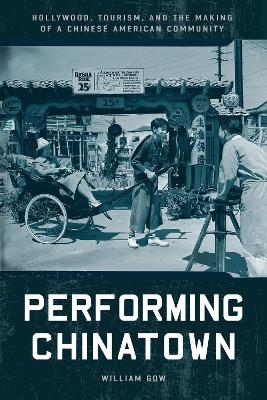
Performing Chinatown
Hollywood, Tourism, and the Making of a Chinese American Community
Seiten
2024
Stanford University Press (Verlag)
978-1-5036-3809-9 (ISBN)
Stanford University Press (Verlag)
978-1-5036-3809-9 (ISBN)
In 1938, China City opened near downtown Los Angeles. Featuring a recreation of the House of Wang set from MGM's The Good Earth, this new Chinatown employed many of the same Chinese Americans who performed as background extras in the 1937 film. Chinatown and Hollywood represented the two primary sites where Chinese Americans performed racial difference for popular audiences during the Chinese exclusion era. In Performing Chinatown, historian William Gow argues that Chinese Americans in Los Angeles used these performances in Hollywood films and in Chinatown for tourists to shape widely held understandings of race and national belonging during this pivotal chapter in U.S. history.
Performing Chinatown conceives of these racial representations as intimately connected to the restrictive immigration laws that limited Chinese entry into the U.S. beginning with the 1875 Page Act and continuing until the passage of the Immigration and Nationality Act of 1965. At the heart of this argument are the voices of everyday people including Chinese American movie extras, street performers, and merchants. Drawing on more than 40 oral history interviews as well as research in more than a dozen archival and family collections, this book retells the long-overlooked history of the ways that Los Angeles Chinatown shaped Hollywood and how Hollywood, in turn, shaped perceptions of Asian American identity.
Performing Chinatown conceives of these racial representations as intimately connected to the restrictive immigration laws that limited Chinese entry into the U.S. beginning with the 1875 Page Act and continuing until the passage of the Immigration and Nationality Act of 1965. At the heart of this argument are the voices of everyday people including Chinese American movie extras, street performers, and merchants. Drawing on more than 40 oral history interviews as well as research in more than a dozen archival and family collections, this book retells the long-overlooked history of the ways that Los Angeles Chinatown shaped Hollywood and how Hollywood, in turn, shaped perceptions of Asian American identity.
William Gow is an Assistant Professor at California State University, Sacramento, and a community historian with the Chinese Historical Society of Southern California, a non-profit in Los Angeles Chinatown.
Illustrations
Acknowledgments
A Note on the Romanization of Chinese
Names and Places
Introduction
PART I: CHINATOWN TOURISM
1. Chinatown Pastiche
2. China City and New Chinatown on Broadway
PART II: HOLLYWOOD EXTRAS
3. Chinese American Extras During the Great Depression
4. Oppositional Spectatorship and The Good Earth
PART III: WARTIME LOS ANGELES
5. Performing Japanese Villains in Wartime Hollywood
6. Mei Wah Girls' Drum Corps and the 1938 Moon Festival
Conclusion
Epilogue
Notes
Selected Bibliography
Index
| Erscheinungsdatum | 18.04.2024 |
|---|---|
| Reihe/Serie | Asian America |
| Zusatzinfo | 2 tables, 38 halftones, 1 map |
| Verlagsort | Palo Alto |
| Sprache | englisch |
| Maße | 152 x 229 mm |
| Themenwelt | Kunst / Musik / Theater ► Film / TV |
| Geisteswissenschaften ► Geschichte ► Regional- / Ländergeschichte | |
| Geschichte ► Teilgebiete der Geschichte ► Kulturgeschichte | |
| Sozialwissenschaften ► Kommunikation / Medien ► Medienwissenschaft | |
| ISBN-10 | 1-5036-3809-X / 150363809X |
| ISBN-13 | 978-1-5036-3809-9 / 9781503638099 |
| Zustand | Neuware |
| Haben Sie eine Frage zum Produkt? |
Mehr entdecken
aus dem Bereich
aus dem Bereich
der stille Abschied vom bäuerlichen Leben in Deutschland
Buch | Hardcover (2023)
C.H.Beck (Verlag)
23,00 €
vom Mittelalter bis zur Gegenwart
Buch | Softcover (2024)
C.H.Beck (Verlag)
12,00 €


